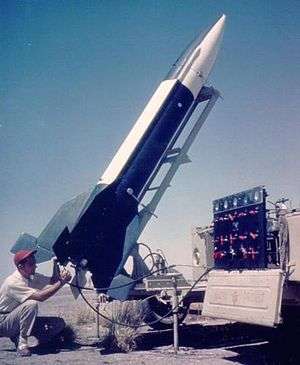RTV-A-3 NATIV
| RTV-A-3 NATIV | |
|---|---|
|
A RTV-A-3 is prepared for a launch test | |
| Type | Experimental test rocket |
| Place of origin | United States |
| Service history | |
| In service | 1948 |
| Used by | United States Air Force |
| Production history | |
| Designed | 1947 |
| Manufacturer | North American Aviation |
| Number built | 7 |
| Specifications | |
| Weight | 1,200 pounds (540 kg) |
| Length | 13 feet 4 inches (4.06 m) |
| Diameter | 18 inches (460 mm) |
|
| |
| Engine |
Rocket 2,600 lbf (12 kN) |
| Wingspan | 4 feet 3.5 inches (1.308 m) |
| Propellant | liquid fuel |
Operational range | 40 miles (64 km) |
| Flight ceiling | 63,000 feet (19,000 m) |
| Speed | c. Mach 3 |
Guidance system | None |
The RTV-A-3 NATIV was an experimental missile program, developed by North American Aviation for the United States Air Force in the late 1940s to test and evaluate guided missile technologies.
Originally given the project number MX-770,[1] NATIV - the North American Test Instrument Vehicle - was influenced by the design of the Wasserfall surface-to-air missile developed in Germany during World War II.[2] Used as a test vehicle for missile technology on behalf of the SM-64 Navaho project,[1] information on the results of the NATIV project are inconsistent. with some sources claiming six successes of 20 launch attempts,[2] while others suggest only one of six launch attempts was a partial success.[3]
References
- Notes
- Bibliography
This article is issued from Wikipedia - version of the 5/8/2014. The text is available under the Creative Commons Attribution/Share Alike but additional terms may apply for the media files.
